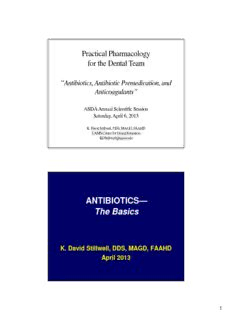
ANTIBIOTICS— The Basics PDF
Preview ANTIBIOTICS— The Basics
Practical Pharmacology for the Dental Team “Antibiotics, Antibiotic Premedication, and Anticoagulants” ASDA Annual Scientific Session Saturday, April 6, 2013 K. David Stillwell, DDS, MAGD, FAAHD UAMS Center for Dental Education [email protected] ANTIBIOTICS— The Basics K. David Stillwell, DDS, MAGD, FAAHD April 2013 1 Antibiotic History I • 1946: Civilian use of penicillin • 1950’s: New antibiotics Tetracycline's Cephalosporins Erythromycins • 1960’s: Lincomycin Antibiotic History II • 1970’s: Clindamycin Vancomycin • 1980-90’s: “Fine tuning” of present antibiotics (Zithromax) with no really new antibiotics • 100+ antibiotics in use today in US • Possible NEW antibiotic out. 2 Resistance ! • Lancet 2/9/07: • “The effect of a single course of antibiotics was felt as much as 180 days after treatment ended (in producing resistance in bacteria)” • “Physicians should take into account the striking ecological side-effects when prescribing antibiotics” Resistance Growth • Each time an antibiotic is taken a small number of microbes develop resistance genes • These resistant microbes multiply in the absence of non-resistant microbes • Can transfer these genes to other species of microbes through conjugation • New strains then develop and the cycle continues 3 “Ideal” Antibiotic • Targets one organism (“the” organism). • No “friendlies” hit • Side effects minimal (allergies, GI, etc.) • One tablet a day (patient compliance) • Take for a maximum of 3-5 days • No resistant strains developed • Low cost Antibiotic Principles 1. Presence of infection: Patient should have an infection! 2. Host’s defense: Host should be able to mount a fight against defense—defense has “final say” and not antibiotic 3. Eliminate source of infection: This is especially true in dentistry 4 Antibiotic Choice 1. Know the organism (ID) 2. Know the sensitivity of organism 3. Desire a narrow spectrum of kill 4. Minimally toxic antibiotic 5. Cidal over static 6. Proven history for similar infections 7. Low cost Why Bactericidal? • Causes bacterial cell death NOT just slowing down cell growth • Quicker than static in helping eliminate infection • Produces longer lasting effects • Better for short term dosing – AHA • NEVER mix a cidal and static – get good medication history 5 Antibiotic Administration • Choices: 1. Dose 2. Interval between doses 3. Route of administration 4. When to monitor (check-up on) the patient after antibiotic administration • These are your choices Antibiotic: Dose • MIC: Minimum inhibitory concentration as determined by pharmaceutical industry • Need 3 to 4 times MIC (typical dose) • Loading dose: Usually double the standard dose then followed by recommended dosing—good idea for potentially “serious” infections or potentially compromised host 6 Antibiotic: Interval • The interval is determined by the half life of the antibiotic • The interval is determined by the host’s clearance capacity. A measure of patient’s liver/renal function • The interval is also determined by the patient’s compliance level Antibiotic: Route • Your choice of: 1. Parenteral: IV and IM. Consider IM if worried about seriousness of infection or patient compliance – ER case? 2. Sub Q: No real place in dentistry 3. Oral: Comprises 99.9% of DMD/DDS antibiotics. However, least predictable due to variable absorption rates in gut 7 Antibiotics: Patient Monitoring • Wait a full 48 hours before changing dose, adding another antibiotic or switching antibiotics • Most decisions after 72 hours depending upon patient response • MUST see the patient before switching (Telephones have poor eyesight.) • Make sure patient takes full Rx dose Common Adverse Reactions: • Allergy • Nausea and vomiting • Pseudomembranous colitis: Clostridium difficile (becoming more resistant itself) • Inactivation of BC pill: controversial • Renal/Liver toxicity: where is the antibiotic metabolized/eliminated? 8 Antibiotics • Penicillin/Amoxicillin/Augmentin • Cephalosporins • Tetracyclines • Erythromycins • Clarithromycin • Azithromycin • Clindamycin • Metronidazole Penicillin/Amoxicillin • 1929: Discovered by Fleming • First mass produced during WW II • Thought by science that it would “end the era of infections”. The magic bullet • Resistant strains developed in early 50’s, shortly after civilian use began • Amoxicillin: an extended spectrum penicillin 9 Penicillin VK • Oral penicillin • CIDAL: Inhibit enzymes responsible for the last stage of bacterial cell wall synthesis (Beta-lactams) • Less than 50% absorption and eliminated by kidneys • Narrow spectrum: Gram + • Resistance: Continues to grow!!!! Beta- lactamase producers Penicillin VK • Dosing: Rx V-Cillin K 500 mg Disp: 20 tabs Sig: ii (2) tabs stat and i (1) tab q6h until gone • Use in dentistry is decreasing 10
Description: